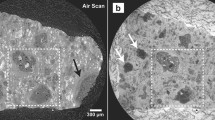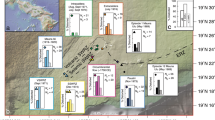Abstract
Rock fabrics—the preferred orientation of grains—provide a window into the history of rock formation, deformation and compaction. Chondritic meteorites are among the oldest materials in the Solar System1 and their fabrics should record a range of processes occurring in the nebula and in asteroids. However, owing to abundant fine-grained material, chondrites have largely resisted traditional in situ fabric analysis. Here we use high-resolution electron backscatter diffraction to map the orientation of submicrometre grains in the Allende CV carbonaceous chondrite. We look at the fine-grained rims surrounding the chondrules—spherical grains cooled from molten droplets before accretion in the meteorite—as well as the matrix material between the chondrules. Although the matrix exhibits a bulk uniaxial fabric indicative of a compressive event in the parent asteroid, we find that the chondrule rims preserve a spherically symmetric fabric centred on the chondrule. We define a method to quantitatively relate fabric intensity to net compression, and reconstruct an initial rim porosity of 70–80%. Our calculations provide meteoritic evidence that the first solids formed in the Solar System accreted with high porosity, similar to modelling and laboratory estimates2,3. We conclude that the chondrule rim textures formed in a nebula setting and may therefore represent the first rock fabric in the Solar System.
This is a preview of subscription content, access via your institution
Access options
Subscribe to this journal
Receive 12 print issues and online access
$259.00 per year
only $21.58 per issue
Buy this article
- Purchase on Springer Link
- Instant access to full article PDF
Prices may be subject to local taxes which are calculated during checkout

Similar content being viewed by others
References
Amelin, Y., Krot, A. N., Hutcheon, I. D. & Ulyanov, A. A. Lead isotopic ages of chondrules and calcium–aluminium-rich inclusions. Science 297, 1678–1683 (2002).
Blum, J. & Schräpler, R. Structure and mechanical properties of high-porosity macroscopic agglomerates formed by random ballistic deposition. Phys. Rev. Lett. 93, 115503 (2004).
Ormel, C. W., Cuzzi, J. N. & Tielens, A. G. G. M. Co-accretion of chondrules and dust in the solar nebula. Astrophys. J. 679, 1588–1610 (2008).
Paque, J. M. & Cuzzi, J. N. Physical characteristics of chondrules and rims, and aerodynamic sorting in the solar nebula. Lunar Planet. Sci. Conf. XXVIII, 71–72 (1997).
Rubin, A. E. Coarse-grained chondrule rims in type 3 chondrites. Geochim. Cosmochim. Acta 48, 1779–1789 (1984).
Tomeoka, K. & Tanimura, I. Phyllosilicate-rich chondrule rims in the Vigarano CV3 chondrite: Evidence for parent-body processes. Geochim. Cosmochim. Acta 64, 1971–1988 (2000).
Trigo-Rodriguez, J. M., Rubin, A. E. & Wasson, J. T. Non-nebular origin of dark mantles around chondrules and inclusions in CM chondrites. Geochim. Cosmochim. Acta 70, 1271–1290 (2006).
Sugiura, N., Matsui, T. & Strangway, D. W. On the natural remanent magnetization in Allende meteorite. Lunar Planet. Sci. 16, 831–832 (1985).
Sneyd, D. S., McSween, H. Y. Jr, Sugiura, N., Strangway, D. W. & Nord, G. L. Jr Origin of petrofabrics and magnetic anisotropy in ordinary chondrites. Meteoritics 23, 139–149 (1988).
Morden, S. J. & Collinson, D. W. The implications of the magnetism of ordinary chondrite meteorites. Earth Planet. Sci. Lett. 109, 185–204 (1992).
Dodd, R. T. Preferred orientation of chondrules in chondrites. Icarus 4, 308–316 (1965).
Martin, P. M. & Mills, A. A. Preferred chondrule orientations in meteorites. Earth Planet. Sci. Lett. 51, 18–25 (1980).
Cain, P. M., McSween, H. Y. Jr & Woodward, N. B. Structural deformation of the Leoville chondrite. Earth Planet. Sci. Lett. 77, 165–176 (1986).
Watt, L. E., Bland, P. A., Prior, D. J. & Russell, S. S. Fabric analysis of Allende matrix using EBSD. Meteorit. Planet. Sci. 41, 989–1001 (2006).
Ramsay, J. G. & Huber, M. I. The Techniques of Modern Structural Geology. Volume 1: Strain Analysis (Academic, 1983).
Harvey, P. K. & Laxton, R. R. The estimate of finite strain from the orientation distribution of passively deformed linear markers: Eigenvalue relationships. Tectonophysics 70, 285–307 (1980).
Consolmagno, G. J., Britt, D. T. & Macke, R. J. What density and porosity tell us about meteorites. Lunar Planet. Sci. Conf. XXXIX, #1582 on CD-ROM (2008).
McSween, H. Y. Jr Petrographic variations among carbonaceous chondrites of the Vigarano type. Geochim. Cosmochim. Acta 41, 1777–1790 (1977).
Ebel, D. S., Leftwich, K., Brunner, C. E. & Weisberg, M. K. Abundance and size distribution of inclusions in CV3 chondrites by X-ray image analysis. Lunar Planet. Sci. Conf. XXXX, #2065 on CD-ROM (2009).
Melosh, H. J. Impact Cratering: A Geologic Process (Oxford Univ. Press, 1989).
Krot, A. N., Petaev, M. I. & Bland, P. A. Multiple formation mechanisms of ferrous olivine in CV3 carbonaceous chondrites during fluid-assisted metamorphism. Antarctic Meteorite Res. 17, 154–172 (2004).
Dominik, C. & Tielens, A. G. G. M. The physics of dust coagulation and the structure of dust aggregates in space. Astrophys. J. 480, 647–673 (1997).
Desch, S. J. & Connolly, H. C. Jr A model of the thermal processing of particles in solar nebula shocks: Application to the cooling rates of chondrules. Meteorit. Planet. Sci. 37, 183–207 (2002).
Hood, L. L., Ciesla, F. J. & Weidenschilling, S. J. in Chondrites and the Protoplanetary Disk (eds Krot, A. N., Scott, E. R. D. & Reipurth, B.) 873–882 (ASP Conference Series, Vol. 341, Astronomical Society of the Pacific, 2005).
Ciesla, F. J. Chondrule collisions in shock waves. Meteorit. Planet. Sci. 41, 1347–1359 (2006).
Prior, D. J., Mariani, E. & Wheeler, J. in Electron Backscatter Diffraction in Materials Science 2nd edn (eds Schwartz, A. J., Kumar, M., Adams, B. L. & Field, D. P.) 345–357 (Springer, 2009).
Owens, W. H. Strain modification of angular density distributions. Tectonophysics 16, 249–261 (1973).
Acknowledgements
We would like to thank F. Ciesla and J. Cuzzi for valuable discussions. This work was supported by the Royal Society.
Author information
Authors and Affiliations
Contributions
P.A.B. designed the project; P.A.B., L.E.H., D.J.P. and R.M.H. collected and analysed the data; J.W. performed strain calculations; P.A.B. wrote the manuscript; K.A.D. contributed to Supplementary Information; L.E.H., D.J.P., J.W. and R.M.H. edited the manuscript.
Corresponding author
Ethics declarations
Competing interests
The authors declare no competing financial interests.
Supplementary information
Supplementary Information
Supplementary Information (PDF 404 kb)
Rights and permissions
About this article
Cite this article
Bland, P., Howard, L., Prior, D. et al. Earliest rock fabric formed in the Solar System preserved in a chondrule rim. Nature Geosci 4, 244–247 (2011). https://doi.org/10.1038/ngeo1120
Received:
Accepted:
Published:
Issue Date:
DOI: https://doi.org/10.1038/ngeo1120
This article is cited by
-
Probing the early stages of shock-induced chondritic meteorite formation at the mesoscale
Scientific Reports (2017)
-
Pressure–temperature evolution of primordial solar system solids during impact-induced compaction
Nature Communications (2014)
-
Microstructure Evolution and Defect Formation in Cu Through-Silicon Vias (TSVs) During Thermal Annealing
Journal of Electronic Materials (2012)
-
Gathering dust
Nature Geoscience (2011)



